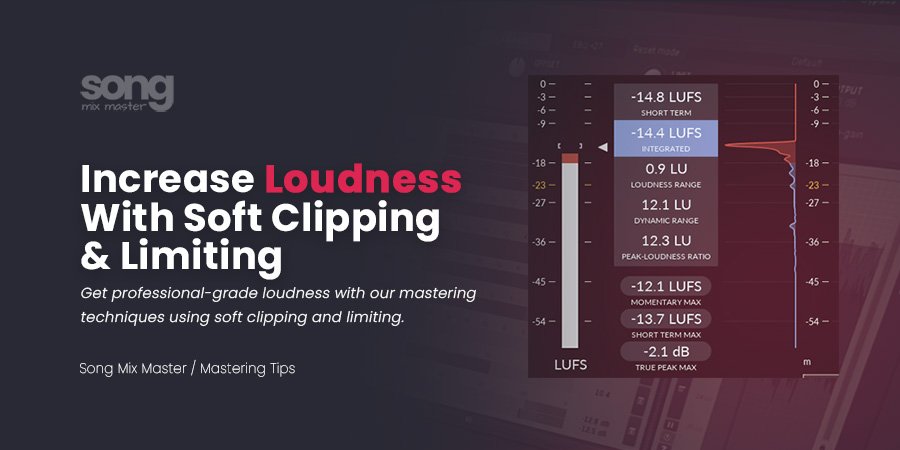Mastering
Increase Mastering Loudness With Soft Clipping and Limiting
When you’re finalizing your mastering process, it’s crucial to focus on the limiting stage. Limiting is the final step in mastering where you maximize the loudness of your track without causing distortion.
This process ensures that your track achieves optimal volume levels, allowing you to upload your song to various streaming platforms with confidence that it will compete in loudness with other tracks.
Effective limiting not only brings your track up to commercial loudness standards but also maintains its clarity and dynamic range, ensuring it sounds professional and polished.
Also read: Mastering for Spotify: Achieving the Perfect LUFS Level
Now, let’s dive into how to get professional-grade loudness with some of my audio mastering techniques using soft clipping and limiting. Learn how to maximize your track’s volume and clarity, ensuring your music competes with industry standards on all streaming platforms.
Soft Clipping
Once you have completed the primary mastering process, you might want your track to sound more powerful, ensuring it stands out when played by artists in your genre. To achieve this, you can optionally apply soft clipping.

Soft clipping is a straightforward technique. Gradually increase the gain and apply the soft clipping process, which trims the shortest transient peaks that limit your track’s volume potential. Be cautious not to overdo it, aiming for a maximum of -4 to -5 RMS.
This method is particularly recommended for producers working with powerful styles such as techno or hard electronic genres. For this purpose, you can use the TR5 Classic Clipper.
Also read: Understanding RMS and LUFS in Audio Mastering
Limiting
To achieve a competitive volume within the music industry, it is essential to perform the limiting process in series using two different limiter plugins. Each limiter imparts a distinct character to your track, and using two limiters instead of one can improve overall performance and yield a superior final result.
Begin by loading the FabFilter Pro L2. Set the style to “Modern” for a transparent and clean sound, apply a high lookahead setting to ensure the limiter catches peaks effectively, and use a fast attack to control transients quickly.

Set the release to a slightly fast setting to maintain a natural sound and adjust the channel linking high for both transient and release to ensure consistent limiting across both stereo channels.
Increase the gain while monitoring the peaks and RMS volume with a peak meter, aiming for an RMS volume between -6 and -7 dB, leaving some headroom for the second limiter in the chain.
Next, load the Invisible Limiter (either version 1 or G2). Set the ceiling between -0.1dB and -0.01dB to avoid clipping and increase the gain on the limiter until you reach the desired final RMS level.
Aim for an overall RMS volume between -6 and -7 dB. For electronic music genres, you might aim for an RMS volume of -5 dB without compromising the natural sound.
Always leave some headroom after the first limiter to ensure the second limiter can further refine and increase the volume without causing distortion. Continuously compare the original and processed versions of your track to ensure the changes are beneficial and maintain the integrity of the audio.
For more intense music styles, you can push your track further by increasing the gain. Use your ears and judgment to guide you, ensuring you maintain the natural sound and dynamics of your track.
By following these guidelines for limiting and soft clipping, your track will achieve optimal volume and impact, ready to compete in the professional music market.
However, audio mastering is a complex and nuanced process that can greatly benefit from expert ears and experience.
If you need a professional to take care of your tracks, consider our online mixing and mastering services.
Also read: The Role Of Audio Clipping in Music


Disclaimer: Any references to any brands on this website/webpage, including reference to products, trademarks, brands and companies, are provided for description purposes only. We don't have any association with or endorsement by these brands or companies. Some of the links on our blog may be affiliate links. This means if you click on these links and make a purchase, we may earn a commission at no extra cost to you.
Need Professional Mixing & Mastering?
You may also like to read...
What is Headroom for Mastering? A Sound Engineer’s Guide
FL Studio Transient Processor: Tips and Best Practices
How To Do FL Studio Sidechain Compression Like a PRO
Soundproofing and Acoustic Treatment – Myths and Realities
How To Release Your Music: Single, Mixtape, EP, or Album?
7 Steps to the Perfect Mix in Hip-Hop, Techno, Rock, and Pop